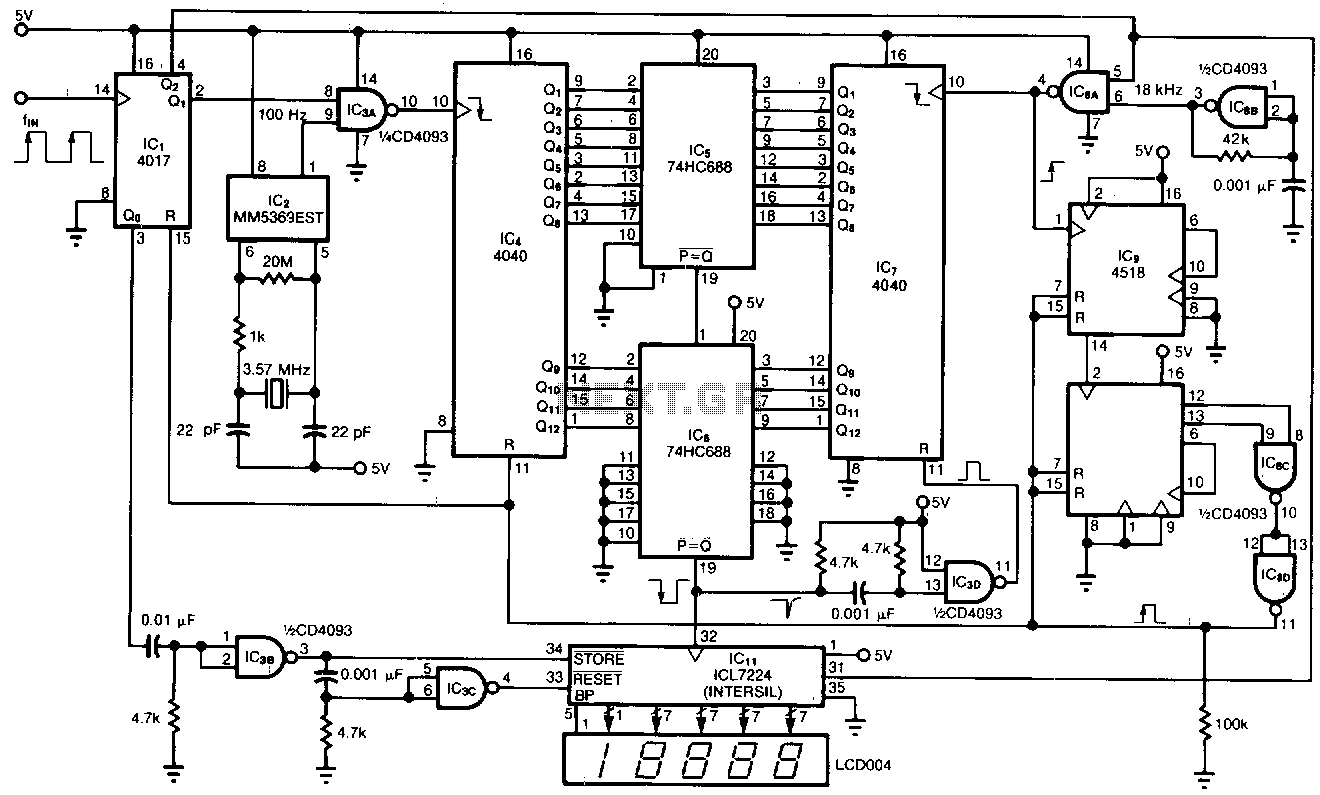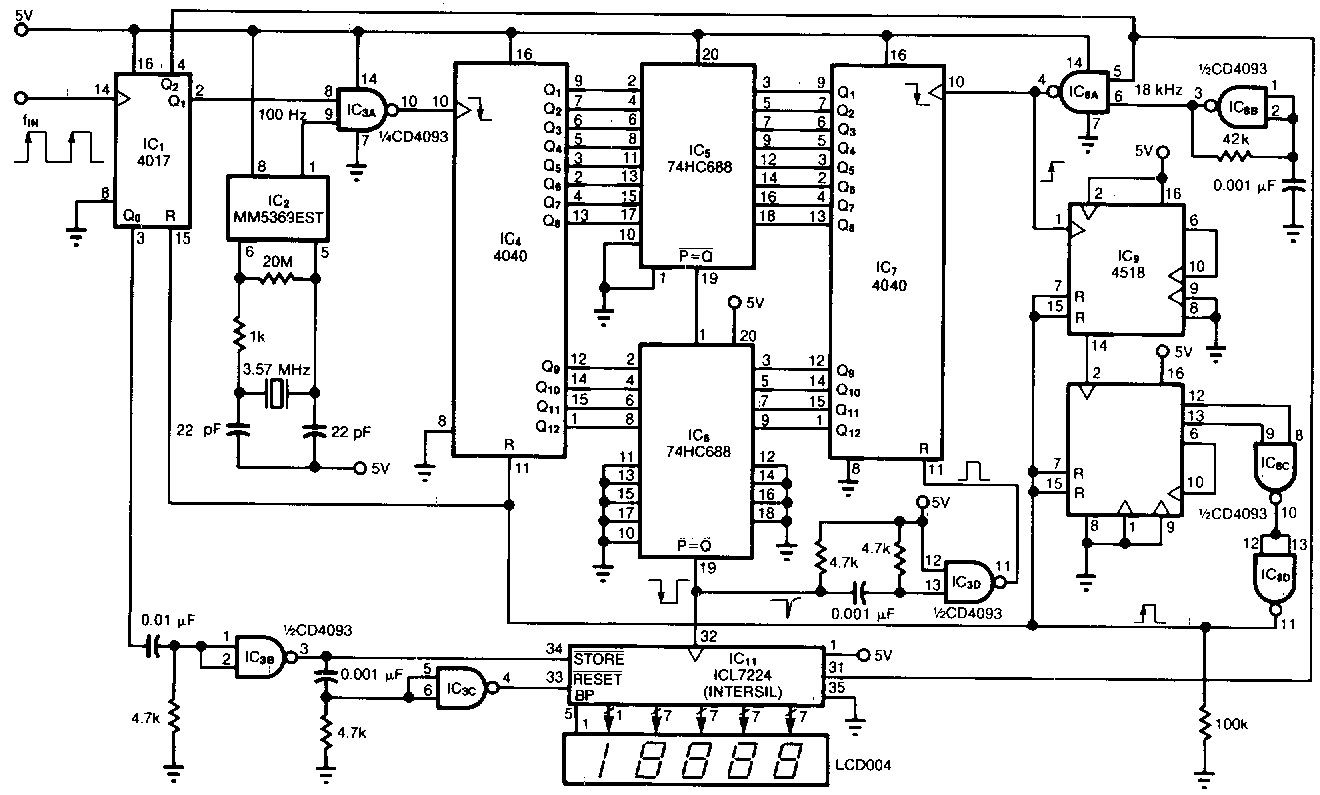
Low-frequency-tachometer

This tachometer allows for the measurement of heartbeats, respiratory rates, and other low-frequency events that occur at intervals ranging from 0.33 to 40.96 seconds. The circuit detects the frequency, calculates the corresponding pulses per minute, and updates the LCD display accordingly. While the decimal readout indicates a frequency of 60 beats per minute, the circuit does not actually generate a frequency of 60 beats per minute. The computation process involves counting and comparison techniques, taking 0.33 seconds to complete. The circuit was presented by Ricardo Jimenez in EDN magazine - Design Ideas.
The tachometer circuit is designed to accurately capture and display physiological metrics such as heart rate and respiratory rate. It operates within a frequency range of 0.025 Hz to 3 Hz, corresponding to the event intervals of 0.33 to 40.96 seconds. The core of the circuit utilizes a microcontroller or a dedicated frequency counter IC, which receives input from a sensor that detects the physiological signals, such as an optical sensor for heartbeats or a microphone for respiratory sounds.
Upon receiving the input signal, the circuit determines the time period of the detected events. This is achieved through a timing mechanism that measures the duration between consecutive signal peaks. The microcontroller then computes the frequency in terms of pulses per minute (PPM) using the formula: PPM = 60 / period (in minutes). This computation is executed every 0.33 seconds, ensuring that the displayed value on the LCD is updated in real-time.
The output is presented on a liquid crystal display (LCD), which is interfaced with the microcontroller. The display is configured to show the calculated beats per minute along with any additional relevant information, such as whether the readings fall within normal physiological ranges.
The circuit's design emphasizes accuracy and responsiveness, leveraging efficient algorithms for counting and comparison. This ensures that the readings are not only timely but also reliable, which is crucial for applications in health monitoring. The inclusion of filtering techniques may also be implemented to minimize noise and improve the fidelity of the readings.
Overall, this tachometer circuit serves as an effective tool for monitoring vital signs, providing valuable data in both clinical and personal health contexts.This tachometer lets you measure heartbeats, respiratory rates, and other low-frequency events that recur at intervals of 0.33 to 40.96 seconds. The circuit senses the period offm, computes the equivalent pulses per minute, and updates the LCD accordingly.
Although the decimal readout equals 60 fm, the circuit doesn"t actually produce a frequency of 60 fm.
The tachometer circuit is designed to accurately capture and display physiological metrics such as heart rate and respiratory rate. It operates within a frequency range of 0.025 Hz to 3 Hz, corresponding to the event intervals of 0.33 to 40.96 seconds. The core of the circuit utilizes a microcontroller or a dedicated frequency counter IC, which receives input from a sensor that detects the physiological signals, such as an optical sensor for heartbeats or a microphone for respiratory sounds.
Upon receiving the input signal, the circuit determines the time period of the detected events. This is achieved through a timing mechanism that measures the duration between consecutive signal peaks. The microcontroller then computes the frequency in terms of pulses per minute (PPM) using the formula: PPM = 60 / period (in minutes). This computation is executed every 0.33 seconds, ensuring that the displayed value on the LCD is updated in real-time.
The output is presented on a liquid crystal display (LCD), which is interfaced with the microcontroller. The display is configured to show the calculated beats per minute along with any additional relevant information, such as whether the readings fall within normal physiological ranges.
The circuit's design emphasizes accuracy and responsiveness, leveraging efficient algorithms for counting and comparison. This ensures that the readings are not only timely but also reliable, which is crucial for applications in health monitoring. The inclusion of filtering techniques may also be implemented to minimize noise and improve the fidelity of the readings.
Overall, this tachometer circuit serves as an effective tool for monitoring vital signs, providing valuable data in both clinical and personal health contexts.This tachometer lets you measure heartbeats, respiratory rates, and other low-frequency events that recur at intervals of 0.33 to 40.96 seconds. The circuit senses the period offm, computes the equivalent pulses per minute, and updates the LCD accordingly.
Although the decimal readout equals 60 fm, the circuit doesn"t actually produce a frequency of 60 fm.
The computation involves counting and comparison techniques and takes 0. 33 seconds. The circuit is posted by Ricardo Jimenez at EDN magazine -Design Ideas.
🔗 External reference